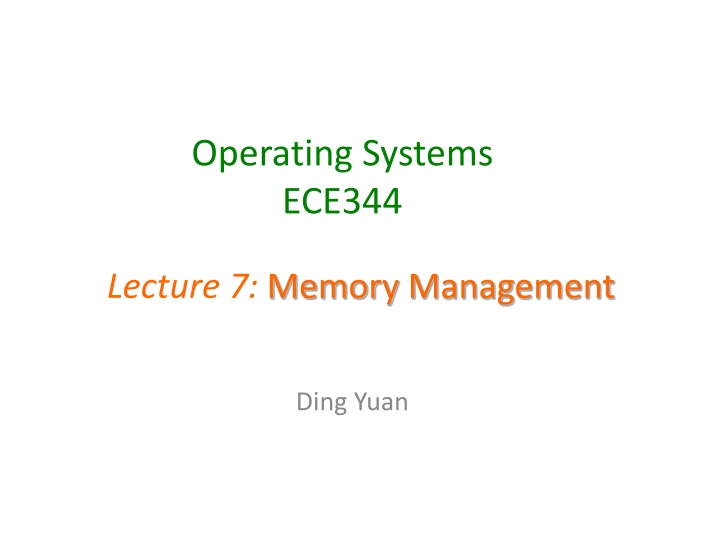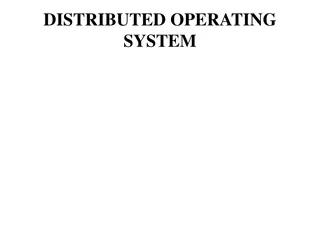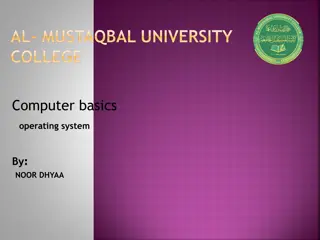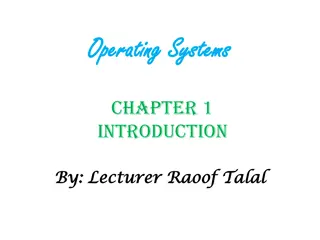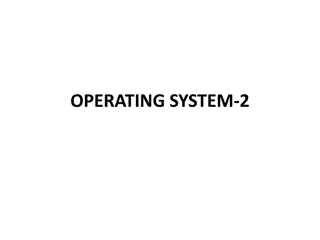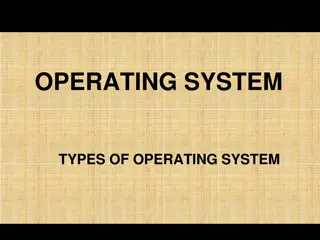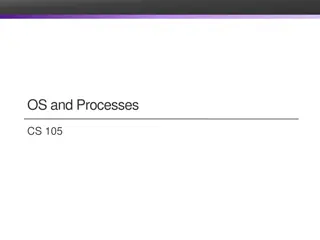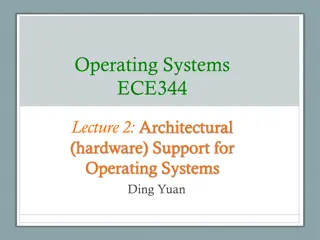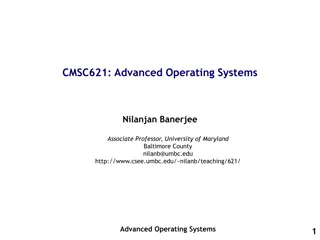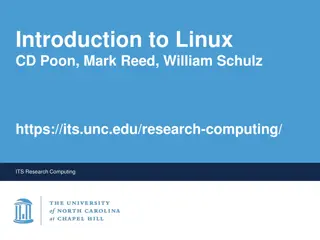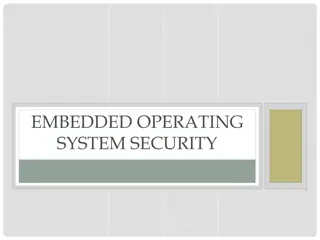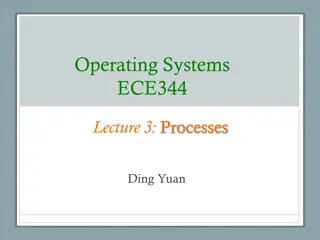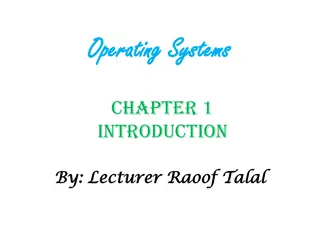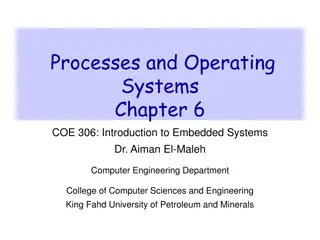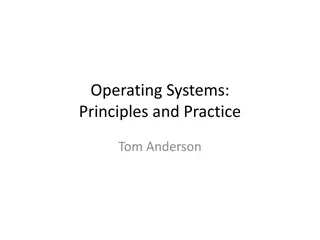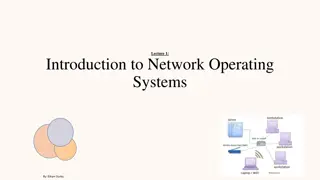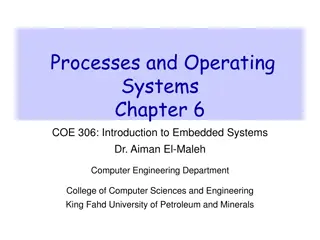Operating Systems ECE344
Memory management is a crucial aspect of operating systems that involves efficiently allocating and deallocating memory resources. This lecture by Ding Yuan delves into the complexities of memory management, covering topics such as memory allocation strategies, virtual memory, memory segmentation, and memory protection mechanisms. Gain insights into how operating systems manage memory to ensure optimal performance and resource utilization.
Download Presentation

Please find below an Image/Link to download the presentation.
The content on the website is provided AS IS for your information and personal use only. It may not be sold, licensed, or shared on other websites without obtaining consent from the author.If you encounter any issues during the download, it is possible that the publisher has removed the file from their server.
You are allowed to download the files provided on this website for personal or commercial use, subject to the condition that they are used lawfully. All files are the property of their respective owners.
The content on the website is provided AS IS for your information and personal use only. It may not be sold, licensed, or shared on other websites without obtaining consent from the author.
E N D
Presentation Transcript
Operating Systems ECE344 Lecture 7: Memory Management Ding Yuan
Memory Management Next few lectures are going to cover memory management Goals of memory management To provide a convenient abstraction for programming To allocate scarce memory resources among competing processes to maximize performance with minimal overhead Mechanisms Physical and virtual addressing (1) Techniques: partitioning, paging, segmentation (1) Page table management, TLBs, VM tricks (2) Policies Page replacement algorithms (3) ECE344 Lec 7 Ding Yuan 2
Lecture Overview Virtual memory Survey techniques for implementing virtual memory Fixed and variable partitioning Paging Segmentation Focus on hardware support and lookup procedure Next lecture we ll go into sharing, protection, efficient implementations, and other VM tricks and features ECE344 Lec 7 Ding Yuan 3
Why Virtual Memory? The abstraction that the OS will provide for managing memory is virtual memory (VM) Enables a program to execute with less than its complete data in physical memory A program can run on a machine with less memory than it needs Many programs do not need all of their code and data at once (or ever) no need to allocate memory for it Processes cannot see the memory of others OS will adjust amount of memory allocated to a process based upon its behavior VM requires hardware support and OS management algorithms to pull it off Let s go back to the beginning ECE344 Lec 7 Ding Yuan 4
In the beginning Rewind to the old days (generally before 1970s) Programs use physical addresses directly OS loads job, runs it, unloads it Multiprogramming changes all of this Want multiple processes in memory at once Overlap I/O and CPU of multiple jobs Can do it a number of ways Fixed and variable partitioning, paging, segmentation Requirements Need protection restrict which addresses jobs can use Fast translation lookups need to be fast Fast change updating memory hardware on context switch ECE344 Lec 7 Ding Yuan 5
Virtual Addresses To make it easier to manage the memory of processes running in the system, we re going to make them use virtual addresses (logical addresses) Virtual addresses are independent of the actual physical location of the data referenced OS determines location of data in physical memory Instructions executed by the CPU issue virtual addresses Virtual addresses are translated by hardware into physical addresses (with help from OS) The set of virtual addresses that can be used by a process comprises its virtual address space ECE344 Lec 7 Ding Yuan 6
Remember this example? int myval; int main(int argc, char *argv[]) { myval = atoi(argv[1]); while (1) printf( myval is %d, loc 0x%lx\n , myval, (long) &myval); } Now simultaneously start two instances of this program Myval 5 Myval 6 What will the outputs be? ECE344 Lec 7 Ding Yuan 7
Virtual Addresses physical addresses virtual addresses physical memory processor vmap Many ways to do this translation Start with old, simple ways, progress to current techniques ECE344 Lec 7 Ding Yuan 9
Fixed Partitions Physical memory is broken up into fixed partitions Hardware requirements: base register Physical address = virtual address + base register Base register loaded by OS when it switches to a process Size of each partition is the same and fixed How do we provide protection? Advantages Easy to implement, fast context switch Problems Internal fragmentation: memory in a partition not used by a process is not available to other processes Partition size: one size does not fit all (very large processes?) ECE344 Lec 7 Ding Yuan 10
Fixed Partitions Physical Memory Base Register P1 P4 s Base P2 Internal fragmentation P3 Virtual Address Offset + P4 P5 ECE344 Lec 7 Ding Yuan 11
Variable Partitions Natural extension physical memory is broken up into variable sized partitions Hardware requirements: base register and limit register Physical address = virtual address + base register Why do we need the limit register? Protection If (physical address > base + limit) then exception fault Advantages No internal fragmentation: allocate just enough for process Problems External fragmentation: job loading and unloading produces empty holes scattered throughout memory ECE344 Lec 7 Ding Yuan 12
Variable Partitions Base Register P1 P3 s Base External fragmentation Limit Register P2 P3 s Limit Virtual Address Yes? Offset < + P3 No? Protection Fault ECE344 Lec 7 Ding Yuan 13
Variable Partitions and Fragmentation Memory wasted by External Fragmentation 1 2 3 4 5 Do you know about disk de-fragmentation? It can improve your system performance! ECE344 Lec 7 Ding Yuan 14
Compaction Processes must be suspended during compaction Need be done only when fragmentation gets very bad 5 6 7 8 9 ECE344 Lec 7 Ding Yuan 15
Paging Paging solves the external fragmentation problem by using fixed sized units in both physical and virtual memory Physical Memory Virtual Memory Page 1 Page 2 Page 3 Page N ECE344 Lec 7 Ding Yuan 16
Internal vs. External fragmentation How paging can solve fragmentation problems? External fragmentation: can be solved by re- mapping between VA and PA Internal fragmentation: can be solved if the page size is relatively small ECE344 Lec 7 Ding Yuan 17
User/Process Perspective Users (and processes) view memory as one contiguous address space from 0 through N Virtual address space (VAS) In reality, pages are scattered throughout physical storage Different from variable partition, where the physical memory for each process is contiguously allocated The mapping is invisible to the program Protection is provided because a program cannot reference memory outside of its VAS The address 0x1000 maps to different physical addresses in different processes ECE344 Lec 7 Ding Yuan 18
Question Page size is always a power of 2 Examples: 4096 bytes = 4KB, 8192 bytes = 8KB Why? Why not 1000 or 2000? ECE344 Lec 7 Ding Yuan 19
Paging Translating addresses Virtual address has two parts: virtual page number and offset Virtual page number (VPN) is an index into a page table Page table determines page frame number (PFN) Physical address is PFN::offset Page tables Map virtual page number (VPN) to page frame number (PFN) VPN is the index into the table that determines PFN One page table entry (PTE) per page in virtual address space Or, one PTE per VPN ECE344 Lec 7 Ding Yuan 20
Page Lookups Physical Memory Virtual Address Page number Offset Physical Address Page Table Page frame Offset Page frame ECE344 Lec 7 Ding Yuan 21
Paging Example Pages are 4K (Linux default) VPN is 20 bits (220 VPNs), offset is 12 bits Virtual address is 0x7468 (hexadecimal) Virtual page is 0x7, offset is 0x468 Page table entry 0x7 contains 0x2000 Page frame number is 0x2000 Seventh virtual page is at address 0x2000 (2nd physical page) Physical address = 0x2000 + 0x468 = 0x2468 ECE344 Lec 7 Ding Yuan 22
Page Lookups Example: how do we load 0x00007468 ? Physical Memory Virtual Address 0 0 0 0 4 6 7 8 Virtual page number Offset Physical Address 0x0002467 0x0002468 .. .. .. .. A 0x0002 468 page frame index .. .. .. .. 0x00006 Questions: 1. How large is the RAM? 2. How big is the page table? 3. Besides page frame, what else we need to store in the page table? 0x00007 .. .. .. .. 0x0002 Page Table ECE344 Lec 7 Ding Yuan 23
Page Table Entries (PTEs) 20 (determined by the size of physical memory) 1 1 1 2 M R V Prot Page Frame Number Page table entries control mapping The Modify bit says whether or not the page has been written It is set when a write to the page occurs The Reference bit says whether the page has been accessed It is set when a read or write to the page occurs The Valid bit says whether or not the PTE can be used It is checked each time the virtual address is used The Protection bits say what operations are allowed on page Read, write, execute The page frame number (PFN) determines physical page If you re interested: watch the OS lecture scene from The Social Network again, see if now you can understand http://www.youtube.com/watch?v=-3Rt2_9d7Jg ECE344 Lec 7 Ding Yuan 24
2-level page table Single level page table size is too large 4KB page, 32 bit virtual address, 1M entries per page table! ECE344 Lec 7 Ding Yuan 25
Two-Level Page Tables Two-level page tables Virtual addresses (VAs) have three parts: Master page number, secondary page number, and offset Master page table maps VAs to secondary page table Secondary page table maps page number to physical page Offset indicates where in physical page address is located Example 4K pages, 4 bytes/PTE How many bits in offset? 4K = 12 bits Want master page table in one page: 4K/4 bytes = 1K entries Hence, 1K secondary page tables. How many bits? Master (1K) = 10, offset = 12, inner = 32 10 12 = 10 bits ECE344 Lec 7 Ding Yuan 27
Two-Level Page Tables Physical Memory Virtual Address Master page number Secondary Offset Physical Address Page table Page frame Offset Master Page Table Page frame Secondary Page Table ECE344 Lec 7 Ding Yuan 28
What is the problem with 2-level page table? Hints: Programs only know virtual addresses Each virtual address must be translated Each program memory access requires several actual memory accesses Will discuss solution in the next lecture ECE344 Lec 7 Ding Yuan 29
Paging Advantages Easy to allocate memory Memory comes from a free list of fixed size chunks Allocating a page is just removing it from the list External fragmentation not a problem Easy to swap out chunks of a program All chunks are the same size Use valid bit to detect references to swapped pages Pages are a convenient multiple of the disk block size ECE344 Lec 7 Ding Yuan 30
Paging Limitations Can still have internal fragmentation Process may not use memory in multiples of a page Memory reference overhead 2 references per address lookup (page table, then memory) Even more for two-level page tables! Solution use a hardware cache of lookups (more later) Memory required to hold page table can be significant Need one PTE per page 32 bit address space w/ 4KB pages = 220 PTEs 4 bytes/PTE = 4MB/page table 25 processes = 100MB just for page tables! Remember: each process has its own page table! Solution 2-level page tables ECE344 Lec 7 Ding Yuan 31
What if a process requires more memory than physical memory? Swapping Move one/several/all pages of a process to disk Free up physical memory Page is the unit of swapping The freed physical memory can be mapped to other pages Processes that use large memory can be swapped out (and later back in) Real life analogy? Putting things from your shelf to your parents house ECE344 Lec 7 Ding Yuan 32
Swapping Physical memory Process 1 ECE344 Lec 7 Ding Yuan 33
Swapping process 1s data into memory Physical memory Process 1 Process 1 ECE344 Lec 7 Ding Yuan 34
Swapping Physical memory Process 1 Process 1 Process 2 ECE344 Lec 7 Ding Yuan 35
Swapping Physical memory Process 1 Process 2 Process 2 ECE344 Lec 7 Ding Yuan 36
A variation of paging: Segmentation Segmentation is a technique that partitions memory into logically related data units Module, procedure, stack, data, file, etc. Virtual addresses become <segment #, offset> Units of memory from user s perspective Natural extension of variable-sized partitions Variable-sized partitions = 1 segment/process Segmentation = many segments/process Hardware support Multiple base/limit pairs, one per segment (segment table) Segments named by #, used to index into table ECE344 Lec 7 Ding Yuan 37
Segment Lookups Segment Table Physical Memory limit base Segment # Offset Virtual Address Yes? < + No? Protection Fault ECE344 Lec 7 Ding Yuan 38
Segment Table Extensions Can have one segment table per process Segment #s are then process-relative Can easily share memory Put same translation into base/limit pair Can share with different protections (same base/limit, diff prot) Problems Large segment tables Keep in main memory, use hardware cache for speed Large segments Internal fragmentation, paging to/from disk is expensive ECE344 Lec 7 Ding Yuan 39
Segmentation and Paging Can combine segmentation and paging The x86 supports segments and paging Use segments to manage logically related units Module, procedure, stack, file, data, etc. Segments vary in size, but usually large (multiple pages) Use pages to partition segments into fixed size chunks Makes segments easier to manage within physical memory Segments become pageable rather than moving segments into and out of memory, just move page portions of segment Need to allocate page table entries only for those pieces of the segments that have themselves been allocated Tends to be complex ECE344 Lec 7 Ding Yuan 40
Summary Virtual memory Processes use virtual addresses OS + hardware translates virtual address into physical addresses Various techniques Fixed partitions easy to use, but internal fragmentation Variable partitions more efficient, but external fragmentation Paging use small, fixed size chunks, efficient for OS Segmentation manage in chunks from user s perspective Combine paging and segmentation to get benefits of both ECE344 Lec 7 Ding Yuan 41
